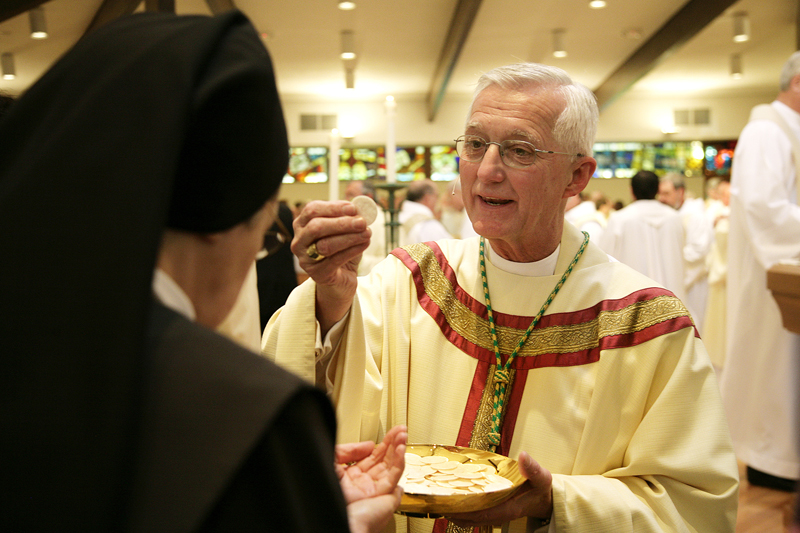By Barb Arland-Fye
The Catholic Messenger
All bishops must submit a letter of resignation when they reach their 75th birthday. Bishop Martin Amos met that milestone Dec. 8, but submitted his resignation letter just before Thanksgiving, he said. He is now fifth from the top of active bishops at or near the age limit in the United States, a statistic he keeps track of on the catholic-hierarchy.org website.
Choosing a new bishop is a lengthy, confidential process that can take six to eight months or more to complete. It begins at the diocesan level and works its way through a series of consultations before it reaches Rome (http:// tinyurl.com/hkvpfte).

Bishop Martin Amos distributes Communion during his installation Mass in 2006 in this file photo. Bishop Amos has submitted his resignation and the process to find a new bishop has begun.
Bishop Amos agreed to share his insights about the general process with The Catholic Messenger. In a sense, the process is ongoing. In the province to which the Davenport Diocese belongs, the Archdiocese of Dubuque, Iowa’s bishops make recommendations for bishop candidates to the archbishop about every three years. The archbishop distributes the names and the curricula vitae at a province meeting where he and his fellow bishops decide on a list of three candidates, called a terna. The bishops are sworn to secrecy to ensure a fair vetting of candidates.
Iowa’s bishops plan to meet in early February at which time they could vote on the terna, Bishop Amos said. Archbishop Michael Jackels will submit the document to the apostolic nuncio in Washington, D.C. and the U.S. Conference of Catholic Bishops. The names of clergy and lay people who know the candidate well will be included in the terna.
“The list isn’t specifically for the Diocese of Davenport, but offers names of candidates for bishops who could serve anywhere,” Bishop Amos noted. Bishops may update the list or remove names from it. If a name is removed, an explanation is required.
After the apostolic nuncio receives the terna, he gathers facts and information about the candidates as well as the conditions and needs of the diocese. In addition to consulting the retiring bishop, the apostolic nuncio confers with the diocese’s previous bishops, province bishops and the president and vice president of the U.S. Conference of Catholic Bishops. The nuncio documents his own recommendation and sends his report, approximately 20 pages, to the Congregation for Bishops.
At each level of the appointment process the vetting of candidates and gathering of information grows, Bishop Amos said. Clergy and lay people who are consulted about a candidate receive a thorough list of questions dealing with topics such as orthodoxy, liturgical style, challenges, and how the priest relates to people. Some respondents aren’t able to answer every question, but their insights are important.
The Nuncio forwards this information to the Congregation for Bishops who study all of the documentation. With the prefect’s approval, the process moves forward. The prefect and his staff generally handle appointments of bishops being promoted or transferred. Priest appointments to the episcopacy generally involve the full congregation. A vote is taken, but the congregation doesn’t have to follow the nuncio’s recommendation and could instead choose another name from the list or ask for another terna to be prepared.
Finally, the congregation’s prefect has a private audience with the Holy Father and presents him with recommendations for appointments. The pope provides his decision a few days later after which the congregation notifies the nuncio, who contacts the candidate and offers him the appointment. If the candidate accepts, the Vatican is notified and a date is set for the announcement.
At the point that a candidate accepts the offer for the Diocese of Davenport, Bishop Amos could be appointed the diocese’s apostolic administrator. “As administrator, you maintain, you don’t make changes.” While he waits, it’s ministry as usual. “My confirmations are starting up next month. The diocese is planning for ordinations,” the bishop said.
“I was telling some people, ‘I enjoy all the things I do. I just don’t want to be in charge. Not being in charge will be a big relief to me.’” For the first six months after his successor takes possession of the diocese, Bishop Amos plans to live in his home diocese of Cleveland, Ohio, where he spent the first 65 years of his life.
His options after that include an invitation to serve as a parochial vicar at a parish in the Diocese of Davenport or help out in the Diocese of Cleveland.











